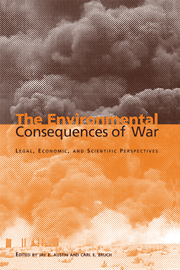Book contents
- Frontmatter
- Contents
- List of illustrations
- List of tables
- List of contributors
- Acknowledgements
- Foreword by Klaus Toepfer
- Introduction
- Part I General principles
- Part II The legal framework
- Introduction
- 2 The law of war and environmental damage
- 3 War and the environment: fault lines in the prescriptive landscape
- 4 The inadequacy of the existing legal approach to environmental protection in wartime
- 5 United States Navy development of operational-environmental doctrine
- 6 In furtherance of environmental guidelines for armed forces during peace and war
- Introduction
- 7 Peacetime environmental law as a basis of state responsibility for environmental damage caused by war
- 8 Environmental damages under the Law of the Sea Convention
- 9 The place of the environment in international tribunals
- 10 Civil liability for war-caused environmental damage: models from United States law
- Part III Assessing the impacts – scientific methods and issues
- Part IV Valuing the impacts – economic methods and issues
- Part V Prospects for the future
- Index
Introduction
Published online by Cambridge University Press: 04 August 2010
- Frontmatter
- Contents
- List of illustrations
- List of tables
- List of contributors
- Acknowledgements
- Foreword by Klaus Toepfer
- Introduction
- Part I General principles
- Part II The legal framework
- Introduction
- 2 The law of war and environmental damage
- 3 War and the environment: fault lines in the prescriptive landscape
- 4 The inadequacy of the existing legal approach to environmental protection in wartime
- 5 United States Navy development of operational-environmental doctrine
- 6 In furtherance of environmental guidelines for armed forces during peace and war
- Introduction
- 7 Peacetime environmental law as a basis of state responsibility for environmental damage caused by war
- 8 Environmental damages under the Law of the Sea Convention
- 9 The place of the environment in international tribunals
- 10 Civil liability for war-caused environmental damage: models from United States law
- Part III Assessing the impacts – scientific methods and issues
- Part IV Valuing the impacts – economic methods and issues
- Part V Prospects for the future
- Index
Summary
Introduction
The body of treaties, customs, and practices governing the environmental consequences of armed conflict is a dynamic and rapidly growing area of international law. Until relatively recently, relevant legal provisions were vague, not directly mentioning the environment. In response to US actions in the Vietnam War, however, the international community adopted the 1976 Convention on the Prohibition of Military or Any Other Hostile Use of Environmental Modification Techniques (ENMOD) and the 1977 Additional Protocols I and II to the Geneva Conventions of 1949.
In addition to the environment-specific provisions of these treaties, authors in this section highlight legal constraints found in a variety of other treaties and international custom protecting property, civilian objects, and cultural heritage, which can provide protection without even mentioning the word “environment.” The different provisions can be divided generally into those that govern targeting choices and those that govern weapons choices; both kinds of regimes can be useful for addressing different aspects of wartime environmental protection. In addition, human rights treaties, arms control agreements, customary international law, and domestic and international peacetime environmental norms also prove useful when considering how to prevent and redress wartime environmental harm.
While this section emphasizes those norms applicable to international armed conflict, there also is a need to consider military operations other than war, which include peacetime training operations, as well as police actions or other activities that do not rise to the level of formally declared war.
- Type
- Chapter
- Information
- The Environmental Consequences of WarLegal, Economic, and Scientific Perspectives, pp. 39 - 46Publisher: Cambridge University PressPrint publication year: 2000
- 2
- Cited by

